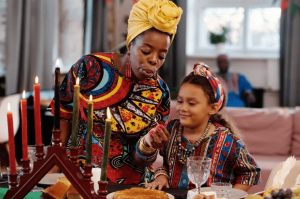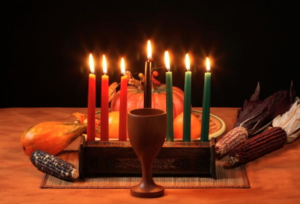
by Jordyn Tribus
As holidays go, Kwanzaa is an extremely beautiful one that is buried beneath other more prominent holidays. Kwanzaa was created by a black studies professor, Dr. Maulana Karenga, at Cal State, Dr. in order to bring African Americans together in 1966 after the Watts riots. This holiday celebrates family, community, and culture. The word Kwanzaa is derived from a Swahili phrase that translates into “first fruits”. This seven-day festival, December 26 – January 1, combines the Ashanti and Zulu cultures into one harvest celebration. Each family celebration is different, yet they share the baseline traditions of song, dance, African drums, storytelling, poetry reading, and a large traditional meal, the “Karamu”. Karamu is held on December 31; this meal consists of rice or couscous, candied yams, buttermilk biscuits, plantains, and fritters, but is not subject to just these items.
Nguzo Saba, the seven principles in Swahili, are the bulk of this holiday’s essence. They are the rules the participating African Americans abide by throughout their lives, and certainly during this time. Each principle is discussed on each night when the candles are ignited. These African values are focused towards building and reinforcing the community among African-Americans. These principles are:
- Umoja (unity): the strive to maintain unity in the family, community, nation, and race
- Kujichagulia (self-determination): to define ourselves, name ourselves, create and speak for ourselves
- Ujima (collective work and responsibility): to build and maintain our community together and make family member’s problems our own and to find solutions to them
- Ujamaa (cooperative economics): to build and maintain our own stores, shops, other businesses and to profit from them together
- Nia (purpose): to make out collective vocation the building and developing of our community in order to restore our people to their traditional greatness
- Kuumba (creativity): always do as much as we can, in the way that we can, in order to leave our community more beautiful and beneficial than we inherited it
- Imani (faith): to believe with all our heart in our people, our parents, our teachers, our leaders, and the righteousness and victory of struggle

To go along with the Nguzo Saba, there are seven basic symbols of Kwanzaa. Each represents values and concepts reflective of African culture. These symbols are:
- Mazao (crops; fruits, nuts, vegetables): symbolizes work and the basis of the holiday as well as the African harvest celebration to reward productivity and collective labor
- Mkeka (the mat): symbolizes tradition and history on which their foundation is built on
- Kinara (the candle holder): symbolizes the roots and ancestors – continental Africans
- Muhindi (the corn): symbolic of the children and the communities future which they embody
- Kikombe cha Umoja (the unity cup): symbolic of the foundational principle and practice of unity which makes all else possible
- Mishumaa Saba (the seven candles): symbolizes the seven principles- the minimum set of values which African people are urged to live by in order to rescue and reconstruct their lives according to their own image and own needs
- Zawadi (the gifts): symbolic of the labor and love of parents and the commitment made and kept by the children
Candle lighting is a momentous event during this holiday. The kinara is made to encompass seven candles, positioned as such: three red candles (Kujichagulia, Ujima, Kuumba) on the left, then one black candle (Umoja) in the center, and finally three green candles (Ujima, Nia, Imani) on the right. Each night one candle is illuminated starting from left to right. On the first night, a child will light the black, center candles to represent that the people come first. Following the black is the red candle. These three depict the struggles their people face. The future and hope that comes after their struggles are characterized by the green candles.
Kwanzaa is a breathtaking holiday that celebrates family, community, and culture. Next time you go to say Merry Christmas to somebody, keep in mind there are other beautiful and incredible holidays that are overshadowed.











